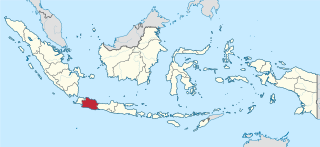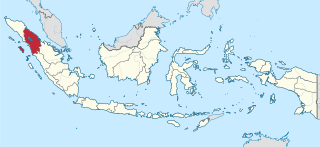
Java is one of the Greater Sunda Islands in Indonesia. It is bordered by the Indian Ocean to the south and the Java Sea to the north. With a population of 156.4 million people, Java is the world's most populous island, home to approximately 56% of the Indonesian population. Indonesia's capital city, Jakarta, is on Java's northwestern coast.

Banten is the westernmost province on the island of Java, Indonesia. Its capital city is Serang and its largest city is Tangerang. The province borders West Java and the Special Capital Region of Jakarta on the east, the Java Sea on the north, the Indian Ocean on the south, and the Sunda Strait on the west and shares a maritime border with Lampung to the west. The province covers an area of 9,352.77 km2 (3,611.12 sq mi). It had a population of over 11.9 million in the 2020 census, up from about 10.6 million in 2010. The estimated mid-2023 population was 12.308 million. Formerly part of the province of West Java, Banten was split off to become a province on 17 October 2000.

West Java is an Indonesian province on the western part of the island of Java, with its provincial capital in Bandung. West Java is bordered by the province of Banten and the country's capital region of Jakarta to the west, the Java Sea to the north, the province of Central Java to the east and the Indian Ocean to the south. With Banten, this province is the native homeland of the Sundanese people, the second-largest ethnic group in Indonesia.

East Java is a province of Indonesia located in the easternmost third of Java island. It has a land border only with the province of Central Java to the west; the Java Sea and the Indian Ocean border its northern and southern coasts, respectively, while the narrow Bali Strait to the east separates Java from Bali by around 2.29 kilometres (1.42 mi). Located in eastern Java, the province also includes the island of Madura, as well as the Kangean islands and other smaller island groups located further east and the Masalembu archipelago to the north. Its capital is Surabaya, the second largest city in Indonesia, a major industrial center and also a major business center. Banyuwangi is the largest regency in East Java and the largest on the island of Java.

Srivijaya, also spelled Sri Vijaya, was a Buddhist thalassocratic empire based on the island of Sumatra that influenced much of Southeast Asia. Srivijaya was an important centre for the expansion of Buddhism from the 7th to 11th century AD. Srivijaya was the first polity to dominate much of western Maritime Southeast Asia. Due to its location, Srivijaya developed complex technology utilizing maritime resources. In addition, its economy became progressively reliant on the booming trade in the region, thus transforming it into a prestige goods-based economy.

Central Java is a province of Indonesia, located in the middle of the island of Java. Its administrative capital is Semarang. It is bordered by West Java in the west, the Indian Ocean and the Special Region of Yogyakarta in the south, East Java in the east, and the Java Sea in the north. It has a total area of 33,750.37 km2, with a population of 36,516,035 at the 2020 Census making it the third-most populous province in both Java and Indonesia after West Java and East Java. The official population estimate in mid-2023 was 37,608,336 The province also includes a number of offshore islands, including the island of Nusakambangan in the south, and the Karimun Jawa Islands in the Java Sea.

North Sumatra, also called North Sumatra Province, is a province of Indonesia located in the northern part of the island of Sumatra, just south of Aceh. Its capital and largest city is Medan on the east coast of the island. It is bordered by Aceh on the northwest and Riau and West Sumatra on the southeast, by coastlines located on the Indian Ocean to the west, and by the Strait of Malacca to the east.

Wayang is a traditional form of puppet theatre play originating from the Indonesian island of Java. Wayang refers to the entire dramatic show. Sometimes the leather puppet itself is referred to as wayang. Performances of wayang puppet theatre are accompanied by a gamelan orchestra in Java, and by gender wayang in Bali. The dramatic stories depict mythologies, such as episodes from the Hindu epics the Ramayana and the Mahabharata, as well as local adaptations of cultural legends. Traditionally, a wayang is played out in a ritualized midnight-to-dawn show by a dalang, an artist and spiritual leader; people watch the show from both sides of the screen.

Hinduism has historically been a major religious and cultural influence in Java, Indonesia. Hinduism was the dominant religion in the region before the arrival of Islam. In recent years, it has also been enjoying something of a resurgence, particularly in the eastern part of the island.

Cirebon is a port city on the northern coast of the Indonesian island of Java. It is the only coastal city of West Java, located about 40 km west of the provincial border with Central Java, approximately 297 km (185 mi) east of Jakarta, at 6°43′S108°34′E. It had a population of 296,389 at the 2010 census and 333,303 at the 2020 census; the official estimate as at mid 2023 was 341,980.

The Kingdom of Pajang or Sultanate of Pajang was a short-lived Muslim state in Java. It was established by Adiwijaya or Jaka Tingkir, Lord of Boyolali, after a civil war and was a successor to Sultanate of Demak. Adiwijaya claimed to be a descendant of Brawijaya V, the last king of the Majapahit empire, and Trenggana, the sultan of Demak.

The Great Post Road is the name for the historical road that runs across Java that connects Anyer and Panarukan. It was built during the reign of Herman Willem Daendels (1808–1811), governor-general of the Dutch East Indies, using unpaid forced labor that cost thousands of lives.

Cirebon Regency is a regency (kabupaten) of West Java Province of Indonesia. The town of Sumber is its capital. It covers 1,076.76 km2 and had a population of 2,068,116 at the 2010 census and 2,270,621 at the 2020 census; the official estimate as at mid 2023 was 2,360,441. These area and population figures exclude those of Cirebon City, which is an independent administration, although totally surrounded by the regency on its landward side.

The history of the arrival of Islam in Indonesia is somewhat unclear. One theory states that Islam arrived directly from Arabia as early as the 9th century, during the time of the Umayyad and Abbasid caliphates. Another theory credits Sufi travelers for bringing Islam in the 12th or 13th century, either from Gujarat in India or from Persia. Before the archipelago's conversion to Islam, the predominant religions in Indonesia were Hinduism and Buddhism.

Christianity is Indonesia's second-largest religion, after Islam. Indonesia also has the second-largest Christian population in Southeast Asia after the Philippines, the largest Protestant population in Southeast Asia, and the third-largest Christian population in Asia after the Philippines and China, followed by India. Indonesia also has the second-largest Christian population in the Muslim world, after Nigeria, followed by Egypt. Indonesia's 29.4 million Christians constituted 10.47% of the country's population in 2023, with 7.41% Protestant and 3.06% Catholic. Some provinces in Indonesia are majority Christian. In Indonesia, the word Kristen refers to Protestantism, while Catholicism is referred to as Katolik. In the 21st century the rate of growth and spread of Christianity has increased, especially among the Chinese minority.

The Sultanate of Cirebon was an Islamic sultanate in West Java founded in the 15th century. It is said to have been founded by Sunan Gunungjati, as marked by his letter proclaiming Cirebon's independence from Pajajaran in 1482, although the settlement and the polity had been established earlier, in 1445. Sunan Gunungjati also established the Sultanate of Banten. It was one of the earliest Islamic states established in Java, along with the Sultanate of Demak.

The North Coast Road is a road 1,430 km in length, that connects Cilegon and Banyuwangi along the northern coast of Java, particularly between Jakarta and Surabaya.

Parahyangan or Priangan is a cultural and mountainous region in West Java province on the Indonesian island of Java. Covering a little less than one-sixth of Java, it is the heartland of Sundanese people and their culture. It is bordered to the West by Banten province, to the North by the northern coast region of Subang, Cirebon, and Indramayu, to the east by Central Java province, and to the south by the Indian Ocean.

The French and British interregnum in the Dutch East Indies of the Dutch East Indies took place between 1806 and 1816. The French ruled between 1806 and 1811, while the British took over for 1811 to 1816 and transferred its control back to the Dutch in 1816.
After his victory at the Battle of Gegodog in northeast Java, the Madurese rebel leader Trunajaya proceeded westwards to conquer Mataram Sultanate's remaining towns on the north coast of Java. By January 1677, nearly all coastal towns from Surabaya to Cirebon were taken.


















